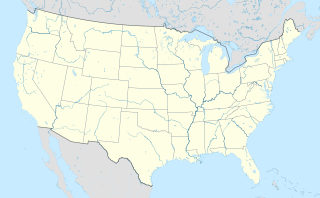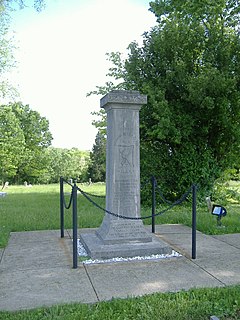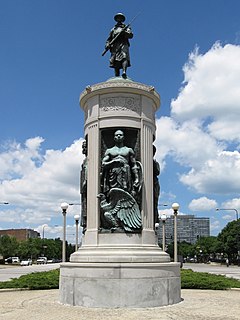 W
WThe 29th Colored Regiment Monument is a monument located in Criscuolo Park in New Haven, Connecticut, United States. The monument commemorates the soldiers of the 29th Connecticut Infantry Regiment (Colored) and is located on the grounds of where more than 900 black recruits trained in 1863. It was designed by Ed Hamilton, a sculptor well known for the Amistad Memorial that is also located in New Haven.
 W
WThe African American Civil War Memorial Museum, in the U Street district of Washington, D.C., recognizes the contributions of the 209,145 members of the United States Colored Troops (USCT). The eponymous memorial, dedicated in July of 1998 by the African American Civil War Memorial Freedom Foundation, commemorates the service of 209,145 African-American soldiers and about 7,000 white and 2,145 Hispanic soldiers, together with the approximate 20,000 unsegregated Navy sailors, who fought for the Union in the American Civil War, mostly among the 175 regiments of United States Colored Troops.
 W
WThe African American Military History Museum, also known as East Sixth Street USO Building, located in Hattiesburg, Mississippi, opened to the public on May 23, 2009. The museum building was originally constructed in 1942 as a USO Club for African American soldiers who were stationed at Camp Shelby. The structure was added to the National Register of Historic Places in 2004 and was designated a Mississippi Landmark in 2010.
 W
WThe African-American Medal of Honor Recipients Memorial is a monument dedicated to African-American recipients of the Medal of Honor since 1861. The sculpture on top, created by Charles Parks, depicts recipients Sgt. William Harvey Carney, who was the first African-American to receive the distinction, for his gallantry in saving the regimental colors during the Battle of Fort Wagner in 1863, and Private Milton L. Olive, who was the first black recipient of the Medal of Honor in the Vietnam War, when he sacrificed himself, age 18, by smothering a live grenade.
 W
WAll Wars Memorial to Colored Soldiers and Sailors is a war memorial in Philadelphia, Pennsylvania that honors the state's African American servicemen who fought in American conflicts from the American Revolutionary War to World War I. Commissioned by the Commonwealth of Pennsylvania in 1927, it was created by sculptor J. Otto Schweizer and dedicated July 7, 1934. In 1994 it was relocated from a remote site in West Fairmount Park to its present prominent site in Logan Square, along the Benjamin Franklin Parkway.
 W
WThe Charles Young Buffalo Soldiers National Monument, a National Monument of the United States, commemorates the life of Charles Young (1864-1922), an escaped slave who rose to become a Buffalo Soldier in the United States Army and its first African-American colonel. It is located on United States Route 42 in Wilberforce, Ohio, in a house purchased by Young in 1907 that was designated a National Historic Landmark in 1974. The monument is administered by the National Park Service; the house is open by appointment for tours.
 W
WThe Colored Soldiers Monument in Frankfort, Kentucky's Green Hill Cemetery, at the junction of US 60 and US 421, is the only Kentucky monument honoring black soldiers that participated in the American Civil War, and one of only four in the entire United States. Erected by the Women's Relief Corps No. 8, an auxiliary of the Grand Army of the Republic, it was unveiled on July 4, 1924. The only other monument built by GAR in Kentucky is the GAR Monument in Covington.
 W
WProspect Bluff Historic Sites is located in Franklin County, Florida, on the Apalachicola River, 6 miles (9.7 km) SW of Sumatra, Florida. The site contains the ruins of two forts – the earlier "Negro Fort", which was constructed by the British in 1814. The British allowed fugitive slaves and Creek tribesmen that had taken refuge with them to occupy it after they evacuated Florida, but the fort was destroyed in an attack from U.S. forces in 1816 including a barrage of cannonballs from gunboats. Fort Gadsden was built in 1818 within the former walls of Negro Fort. The site has been known by several other names at various times, including Prospect Bluff, British post, Nicholls' Fort, Blount's Fort, Fort Blount, African Fort, and Fort Apalachicola.
 W
WThe National Liberty Monument is a proposed national memorial to honor the more than 5,000 enslaved and free persons of African descent who served as soldiers or sailors or provided civilian assistance during the American Revolutionary War. The memorial is an outgrowth of a failed effort to erect a Black Revolutionary War Patriots Memorial, which was authorized in 1986 but whose memorial foundation dissolved in 2005. Congress authorized the National Liberty Monument in January 2013.
 W
WThe Battle of Negro Fort was a brief and destructive siege of a fortification filled with fugitive slaves, free blacks, and Choctaw by the United States and their Creek allies. On Prospect Bluff, overlooking the Apalachicola River, a settlement and fortification that Andrew Jackson and other white Americans labeled Negro Fort existed for a brief period. It was built by the British in 1814, during the War of 1812, in a remote part of what was at the time Spanish Florida. It is part of the Prospect Bluff Historic Sites, in the Apalachicola National Forest, Franklin County, Florida. The term "Negro Fort" was coined by the Americans only after the British Army had departed Florida in the aftermath of the Treaty of Ghent in 1815; its later residents were primarily blacks, either being free Negroes or fugitive slaves, residing together with some Choctaws. There were a significant number of fugitive slaves already in the area before the fort was built, and beginning in 1804 there was for several years a trading post operating in the settlement. The blacks, having been slaves that worked on plantation, knew how to plant and care for crops, and also to care for domesticated animals, mostly cattle.
 W
WThe Memorial to Robert Gould Shaw and the Massachusetts Fifty-Fourth Regiment is a bronze relief sculpture by Augustus Saint-Gaudens opposite 24 Beacon Street, Boston. It depicts Colonel Robert Gould Shaw leading members of the 54th Regiment Massachusetts Volunteer Infantry as it marched down Beacon Street on May 28, 1863 to depart the city to fight in the South. The sculpture was unveiled on May 31, 1897. This is the first civic monument to pay homage to the heroism of African American soldiers.
 W
WThe United States Colored Troops Memorial Statue is a memorial to the more than 700 African-American soldiers and sailors from St. Mary's County, Maryland who served in the Union forces during the American Civil War.
 W
WErected in 1927, the Victory Monument, created by sculptor Leonard Crunelle, was built to honor the Eighth Regiment of the Illinois National Guard, an African-American unit that served in France during World War I. It is located in the Black Metropolis-Bronzeville District in the Douglas community area of Chicago, Illinois. The structure was added to the National Register of Historic Places on April 30, 1986. It was designated a Chicago Landmark on September 9, 1998. An annual Memorial Day ceremony is held at the monument.